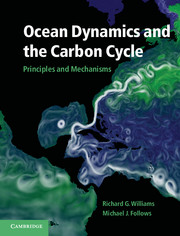Book contents
- Frontmatter
- Contents
- Preface
- Acknowledgements
- Illustration credits
- Part I Introduction
- Part II Fundamentals
- Part III Physical Phenomena and their Biogeochemical Signals
- Part IV Synthesis
- 13 Integral frameworks
- 14 Overview and further challenges
- Appendix
- Symbols and definitions
- Glossary
- Answers
- References
- Index
- Plate section
13 - Integral frameworks
from Part IV - Synthesis
Published online by Cambridge University Press: 05 June 2012
- Frontmatter
- Contents
- Preface
- Acknowledgements
- Illustration credits
- Part I Introduction
- Part II Fundamentals
- Part III Physical Phenomena and their Biogeochemical Signals
- Part IV Synthesis
- 13 Integral frameworks
- 14 Overview and further challenges
- Appendix
- Symbols and definitions
- Glossary
- Answers
- References
- Index
- Plate section
Summary
It is a challenge to understand the role of the ocean in the climate system due to the complex interplay of physical, chemical and biological processes, and their range in spatial scales from diffusion on the molecular scale to overturning on the global scale. While there is widespread interest in the role of the ocean in climate change, it is unclear how the ocean has behaved in the geological past and how the ocean might respond in the future to changes in climate forcing.
In order to gain insight into how the ocean behaves, we now consider two simplifying diagnostic frameworks. The first framework addresses the global carbon cycle, considering the atmosphere and ocean as a container of air overlying water and examines their long-term equilibrium between them. The partitioning of carbon between the air and water depends on the properties of the water (temperature, alkalinity and biological activity), as well as the external inputs and outputs of carbon and minerals. This model is useful for understanding how atmospheric carbon dioxide has varied on millennial timescales in the past, such as during glacial periods, and how it might change in the future with continuing anthropogenic emissions.
The second framework addresses how water masses form, relating the area-integrated density forcing at the sea surface, the interior mixing and the rate at which water masses are transformed between density classes. Patterns of surface density forcing reveal the asymmetry between the overturning in the Atlantic and Pacific, and provide clues as to how the overturning operates in the Southern Ocean.
- Type
- Chapter
- Information
- Ocean Dynamics and the Carbon CyclePrinciples and Mechanisms, pp. 329 - 353Publisher: Cambridge University PressPrint publication year: 2011



